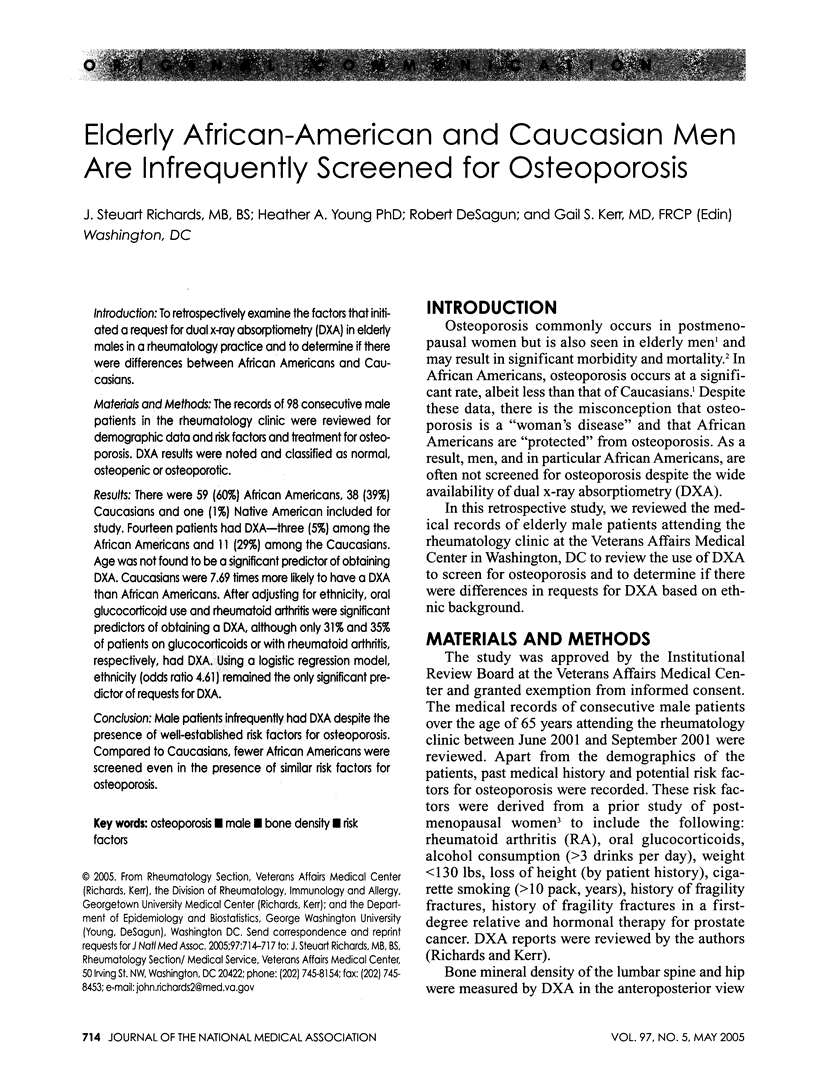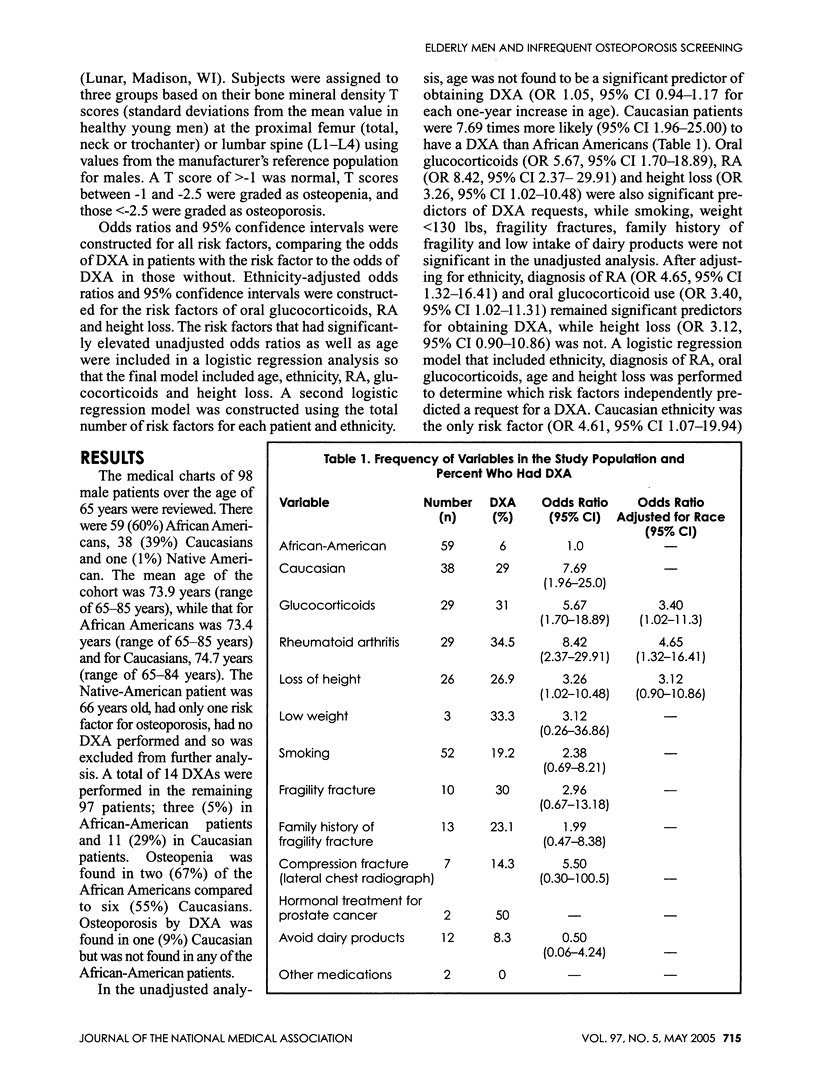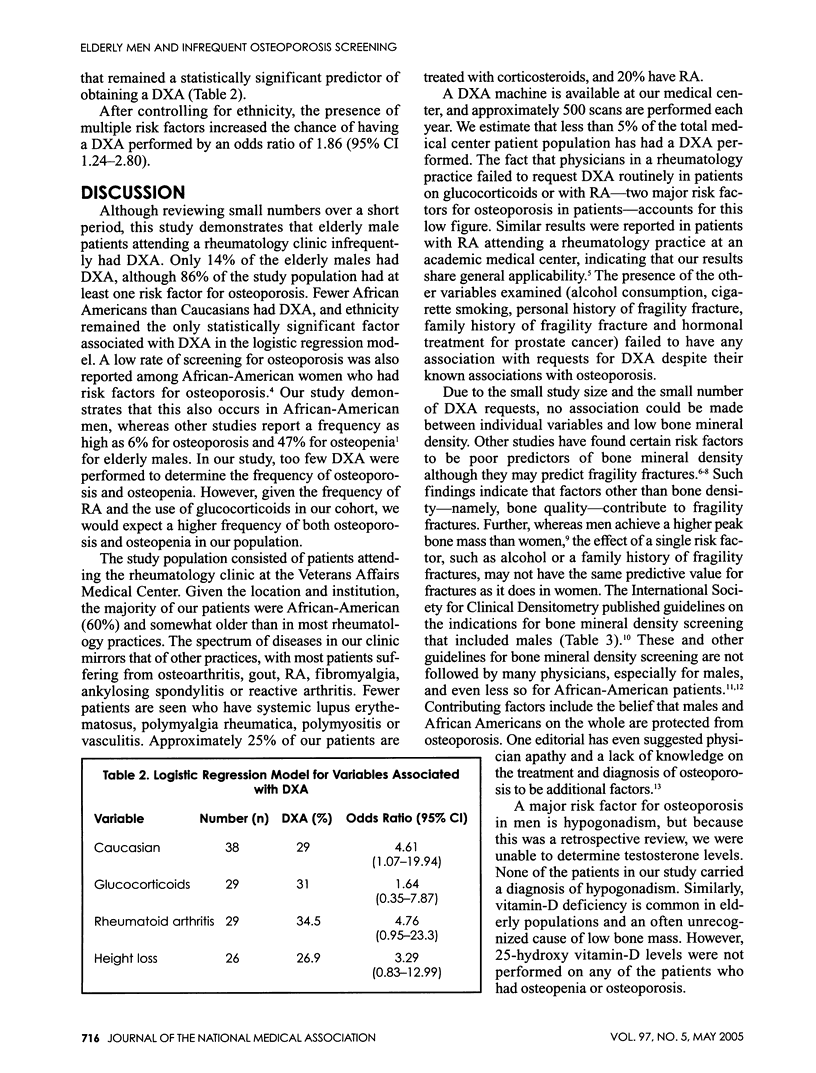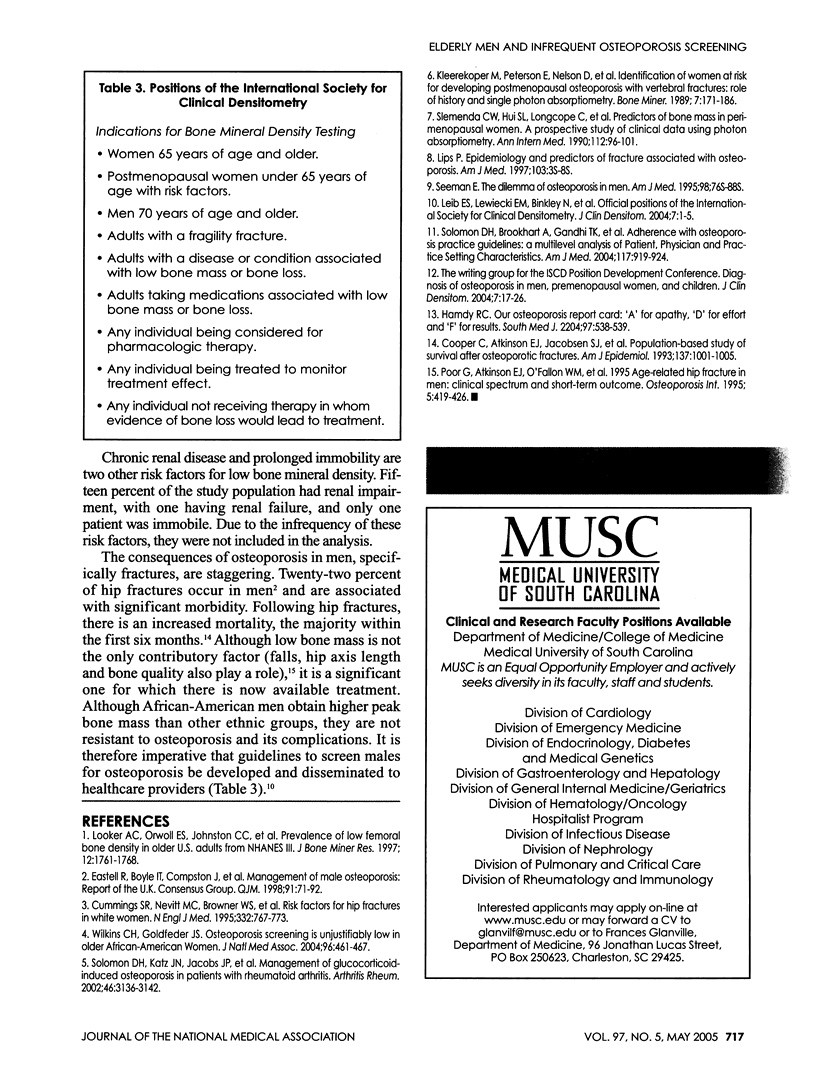Abstract
INTRODUCTION: To retrospectively examine the factors that initiated a request for dual x-ray absorptiometry (DXA) in elderly males in a rheumatology practice and to determine if there were differences between African Americans and Caucasians, MATERIALS AND METHODS: The records of 98 consecutive male patients in the rheumatology clinic were reviewed for demographic data and risk factors and treatment for osteoporosis. DXA results were noted and classified as normal, osteopenic or osteoporotic. RESULTS: There were 59 (60%) African Americans, 38 (39%) Caucasians and one (1%) Native American included for study. Fourteen patients had DXA-three (5%) among the African Americans and 11 (29%) among the Caucasians. Age was not found to be a significant predictor of obtaining DXA. Caucasians were 7.69 times more likely to have a DXA than African Americans. After adjusting for ethnicity, oral glucocorticoid use and rheumatoid arthritis were significant predictors of obtaining a DXA, although only 31% and 35% of patients on glucocorticoids or with rheumatoid arthritis, respectively, had DXA. Using a logistic regression model, ethnicity (odds ratio 4.61) remained the only significant predictor of requests for DXA. CONCLUSION: Male patients infrequently had DXA despite the presence of well-established risk factors for osteoporosis. Compared to Caucasians, fewer African Americans were screened even in the presence of similar risk factors for osteoporosis.
Full text
PDF



Selected References
These references are in PubMed. This may not be the complete list of references from this article.
- Brennan Fionula M., Hayes Amanda L., Ciesielski Cathleen J., Green Patricia, Foxwell Brian M. J., Feldmann Marc. Evidence that rheumatoid arthritis synovial T cells are similar to cytokine-activated T cells: involvement of phosphatidylinositol 3-kinase and nuclear factor kappaB pathways in tumor necrosis factor alpha production in rheumatoid arthritis. Arthritis Rheum. 2002 Jan;46(1):31–41. doi: 10.1002/1529-0131(200201)46:1<31::AID-ART10029>3.0.CO;2-5. [DOI] [PubMed] [Google Scholar]
- Cooper C., Atkinson E. J., Jacobsen S. J., O'Fallon W. M., Melton L. J., 3rd Population-based study of survival after osteoporotic fractures. Am J Epidemiol. 1993 May 1;137(9):1001–1005. doi: 10.1093/oxfordjournals.aje.a116756. [DOI] [PubMed] [Google Scholar]
- Cummings S. R., Nevitt M. C., Browner W. S., Stone K., Fox K. M., Ensrud K. E., Cauley J., Black D., Vogt T. M. Risk factors for hip fracture in white women. Study of Osteoporotic Fractures Research Group. N Engl J Med. 1995 Mar 23;332(12):767–773. doi: 10.1056/NEJM199503233321202. [DOI] [PubMed] [Google Scholar]
- Eastell R., Boyle I. T., Compston J., Cooper C., Fogelman I., Francis R. M., Hosking D. J., Purdie D. W., Ralston S., Reeve J. Management of male osteoporosis: report of the UK Consensus Group. QJM. 1998 Feb;91(2):71–92. doi: 10.1093/qjmed/91.2.71. [DOI] [PubMed] [Google Scholar]
- Kleerekoper M., Peterson E., Nelson D., Tilley B., Phillips E., Schork M. A., Kuder J. Identification of women at risk for developing postmenopausal osteoporosis with vertebral fractures: role of history and single photon absorptiometry. Bone Miner. 1989 Sep;7(2):171–186. doi: 10.1016/0169-6009(89)90074-3. [DOI] [PubMed] [Google Scholar]
- Leib Edward S., Lewiecki E. Michael, Binkley Neil, Hamdy Ronald C., International Society for Clinical Densitometry Official positions of the International Society for Clinical Densitometry. J Clin Densitom. 2004 Spring;7(1):1–6. doi: 10.1385/jcd:7:1:1. [DOI] [PubMed] [Google Scholar]
- Looker A. C., Orwoll E. S., Johnston C. C., Jr, Lindsay R. L., Wahner H. W., Dunn W. L., Calvo M. S., Harris T. B., Heyse S. P. Prevalence of low femoral bone density in older U.S. adults from NHANES III. J Bone Miner Res. 1997 Nov;12(11):1761–1768. doi: 10.1359/jbmr.1997.12.11.1761. [DOI] [PubMed] [Google Scholar]
- Poór G., Atkinson E. J., Lewallen D. G., O'Fallon W. M., Melton L. J., 3rd Age-related hip fractures in men: clinical spectrum and short-term outcomes. Osteoporos Int. 1995;5(6):419–426. doi: 10.1007/BF01626602. [DOI] [PubMed] [Google Scholar]
- Slemenda C. W., Hui S. L., Longcope C., Wellman H., Johnston C. C., Jr Predictors of bone mass in perimenopausal women. A prospective study of clinical data using photon absorptiometry. Ann Intern Med. 1990 Jan 15;112(2):96–101. doi: 10.7326/0003-4819-112-2-96. [DOI] [PubMed] [Google Scholar]
- Solomon Daniel H., Brookhart M. Alan, Gandhi Tejal K., Karson Andrew, Gharib Soheyla, Orav E. John, Shaykevich Shimon, Licari Andrea, Cabral Danielle, Bates David W. Adherence with osteoporosis practice guidelines: a multilevel analysis of patient, physician, and practice setting characteristics. Am J Med. 2004 Dec 15;117(12):919–924. doi: 10.1016/j.amjmed.2004.06.040. [DOI] [PubMed] [Google Scholar]
- Wilkins Consuelo H., Goldfeder Jason S. Osteoporosis screening is unjustifiably low in older African-American women. J Natl Med Assoc. 2004 Apr;96(4):461–467. [PMC free article] [PubMed] [Google Scholar]
- Writing Group for the ISCD Position Development Conference Diagnosis of osteoporosis in men, premenopausal women, and children. J Clin Densitom. 2004 Spring;7(1):17–26. doi: 10.1385/jcd:7:1:17. [DOI] [PubMed] [Google Scholar]


